Town Hall Square, Hattersheim Germany
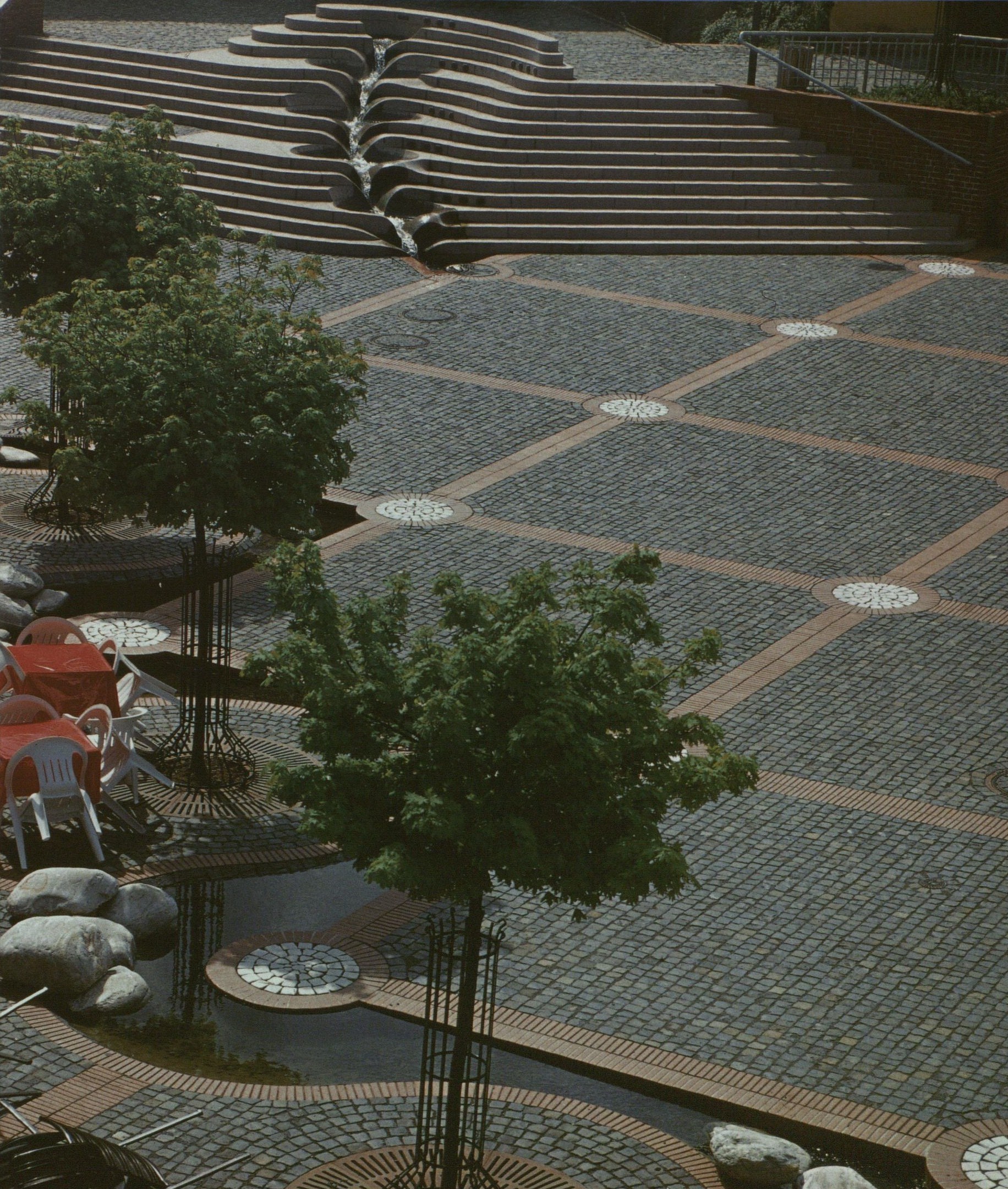 |
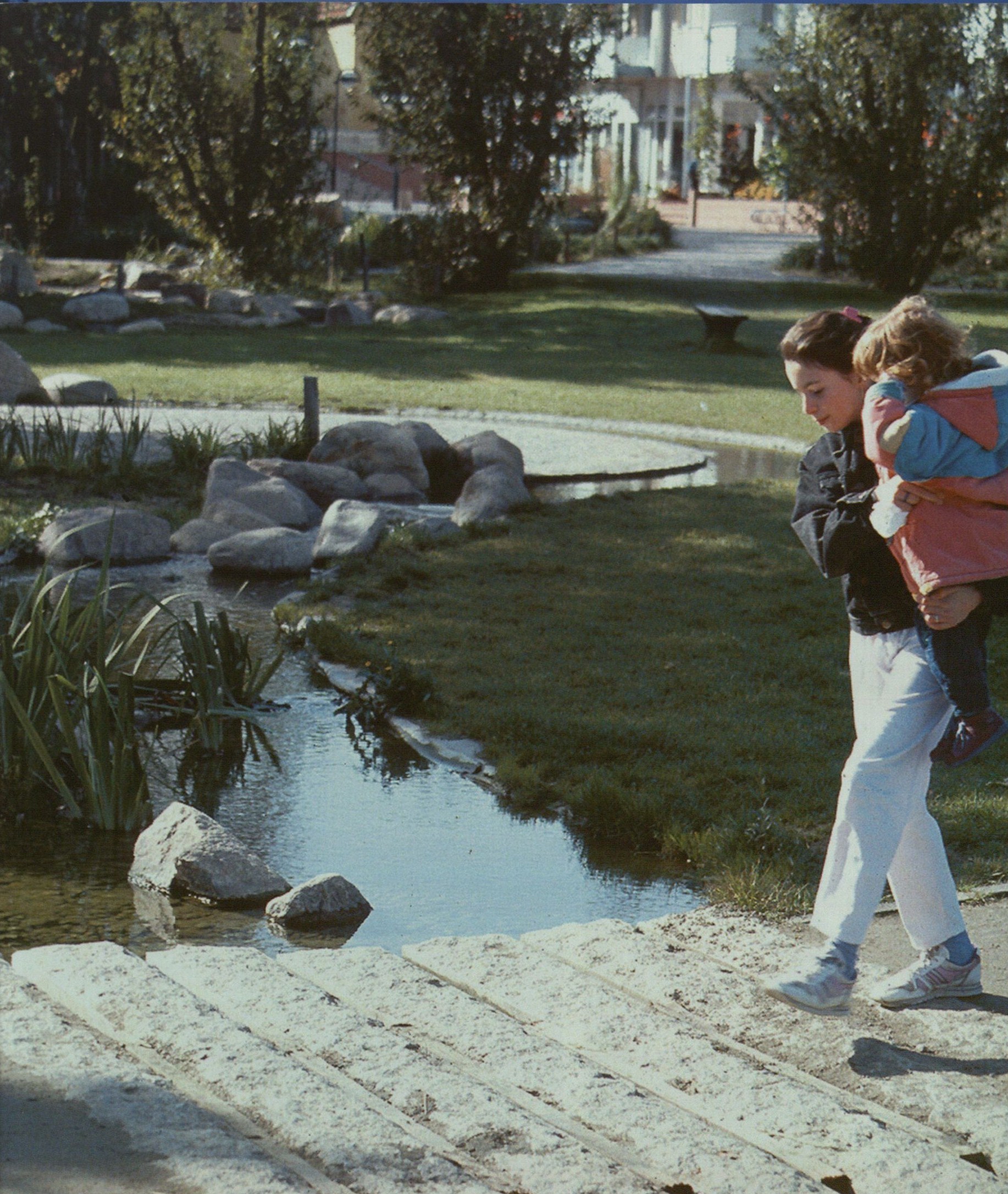 |
| Image from New Waterscapes: planning, building, and designing with water. | Image from New Waterscapes: planning, building, and designing with water. |
Project Background
Hattersheim is a small German town south of Frankfurt. In the 1980s, Hattersheim began to address the issues related to the underused public spaces. In particular, Hattersheim wanted to make the town’s public squares and parks more attractive to its urban residents as a way to encourage use and civic engagement. The main focus of the town’s efforts became the town center. In the late 1980s, Hattersheim announced a competition to redesign the Town Hall Square and a nearby Municipal Park.
Vision
In 1988, Atelier Dreiseitl won the competition with a design that connected the urban elements of the Town Hall Square to the natural landscape of the Municipal Park through an artistic and functional watercourse. According to Herbert Dreiseitl, the design was intended to invoke images of how the two extremes of human habitation, the constructed urban and more natural rural landscapes, coexist within the city.
Atelier Dreiseitl’s design used water as a symbol of the unifying life source that connects all aspects of the physical world. As such, the watercourse was designed as a continuous stream of running water that connected the Town Hall Square and Municipal Park. In addition to the physical connection of the two spaces, the design of the watercourse symbolically connected the constructed landscape of the square to the naturalistic landscape of the park through the use of flowing water that runs through both the man-made features and the natural elements. The goal was to illuminate the role of water at work in both a constructed urban environment and an open park landscape in order to demonstrate the essential hydraulic processes continuously at work throughout the city.
Design
The design of the watercourse for Hattersheim’s Town Hall Square and Municipal Park centered on a continuous stream of water that would run through the Town Hall Square to the Municipal Park, physically connecting the two spaces with the natural element. The water begins at the top of a set of hand-carved granite steps, and the water then cascades down the steps through a series of basins and falls into a small pool at the base. From there, the water disappears under stone paving and reappears on the other end of the Town Hall Square in the form of a meandering urban stream. The stream disappears underground again and reemerges as a more natural looking stream, which winds down to a retention pond in the Municipal Park.
 |
| Image from google earth |
To the observer, it is at this point that the stream appears to end; however, the water continues to move underground and out of sight. The water moves into an underground tank and then is pumped back up to the Town Hall steps to begin its journey again. Thus the water used in the system is continuously recycled and reused within the system.
As the water runs through the watercourse from the Town Hall steps to the retention pond in the park, its environment evolves from constructed to natural, from urban to rural. The stream is continuous, yet interacts with a changing environment.
Featured Artistic Elements
The main artistic element of the project is the set of steps leading down into Hattersheim’s Town Hall Square. As the visual source of the system’s water, the stairs play a central role in the project’s design objectives of connecting various urban processes to water.
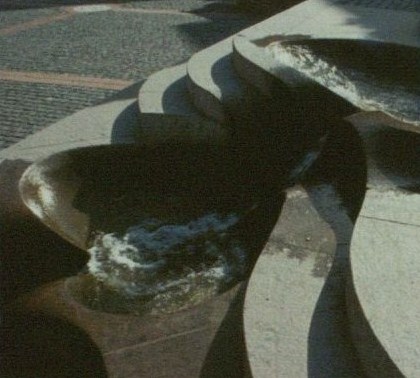 |
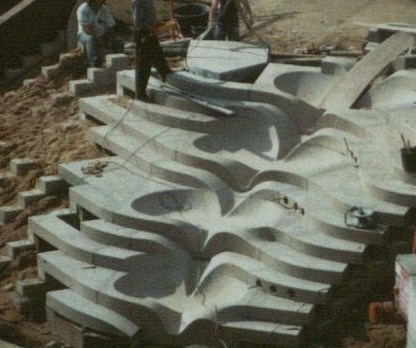 |
| Image from New Waterscapes: planning, building, and designing with water. | Image from New Waterscapes: planning, building, and designing with water. |
The stairs are hand-crafted from large granite blocks to mimic the effects of water flowing over the steps over time, wearing away and eroding the stone until new shapes are formed. On its way down the steps, the water passes through four flowform basins designed using the John Wilkes flowform principle. The figure-eight basins mimic the natural flow of water through space and create rhythms intended to mimic the human pulse. Thus, through the stairs, water is connected to constructed form, the process of time, human life in such a way that can be experienced both visually and auditorily.
 |
| Image from New Waterscapes: planning, building, and designing with water. |
The secondary artistic element included in the design is the urban stream that meanders through the square before the water enters the park. The main goal of this element is to juxtapose the urban and rural instances of water. The curving path of the water itself evokes images of old meandering streams running through a natural environment. However, through the design of its banks, the stream becomes at once urban and natural. One side is designed to evoke natural elements: the edges are curved around planted trees and lined with stones for the water to trickle over. The opposite bank of the urban stream is constructed with sharp angles and lined with bricks. The water runs through these two environments, suggesting the connection between these two distinct landscapes is water.
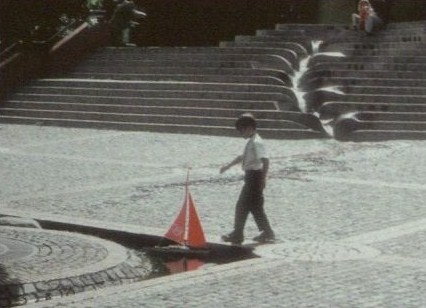 |
| Image from New Waterscapes: planning, building, and designing with water. |
The two main instances of water art included in Atelier Dreiseitl’s design for the Town Hall Square play with the natural qualities of water in a way that is supposed to encourage people to experience water in new ways. The artistic interventions go beyond the traditional visual experience of public art and engage people’s auditory senses through the changing sounds of water as it runs through various environments.
Additionally, the similar appearance and use of water in both constructed and natural spaces is meant to illustrate the connections between urban and natural processes. By showing the public how water behaves in constructed and untouched environments, the designers hoped to communicate the important roles natural water processes play in the urban environment.
The design consciously focuses on the natural qualities of water. The only elements that dictate how the water moves is gravity and the shape of the containers the water is placed in. To the public, the path the water takes, the way it flows and responds to light, and the way it sounds is controlled only by the sculptural elements of the water art.
Engineered Systems
Although the visible elements of the design center on the idea of expressing natural water processes, it is important to note that the water art system would cease to function without an integrated engineered water system running underground. Although I have been unable to determine the exact specifications of the system’s configuration, the longitudinal section of the system through the park section of the watercourse included in Waterscapes describes the basic functional elements.
 |
| Image from New Waterscapes: planning, building, and designing with water. |
After the water runs through the Town Hall Square, it enters the more natural (it is, in actuality, a constructed landscape) section of the watercourse. Here, the main filtration element is the purification biotope, which the water runs through before it reaches the cistern. The storage cistern appears to have two submerged pumps: one which pumps the filtered water back to the source on the top of the stairs and the second to pump the water into a retention pond. The retention pond also aids with site drainage and storm-water retention. It is assumed that coarse pre-filters are used in both instances where the water flows underground in the Town Hall Square so that large pollutants do not enter the system underground.
For more information on the technical aspects of Atelier Dreiseitl’s projects see the Atelier Dreiseitl Engineering section of this webpage.
Analysis
The design of Hattersheim’s Town Hall Square plays with the idea of how natural water processes interact with different, yet connected, environments. The design explores the apparent contradiction of dependent urban and rural spaces and tries to demonstrate the important role of water to the people who use the space. However, the manifestation of the design itself reveals contradictions in the design’s vision.
The design focuses on connecting urban and rural spaces through the common natural water process at work in each. However, there is a disconnection between the natural processes the waterscape is supposed to represent and the actual hidden processes that make the system functional. Symbolically, the continuous stream of water through the changing landscape from urban to rural demonstrates the connection between urban and rural spaces. However, the water itself does not represent the actual process that make the system function because these elements are hidden from the viewer.
The stairs, the main artistic feature in the square, are designed to symbolize the natural process of erosion on the constructed landscape and to represent life processes through the rhythmic patterns of the water flowing through the flowform basins.
In addition to the symbolic images incorporated into the design of the square, the stairs represent the source of the water processes in the square. However, the stairs do not incorporate any visible reference to the source of the water or to how the system works. There is no visible way for viewers to understand where the water is coming from or how it relates to the park.
The trend of invisible functional systems continues throughout the square. There are no visible connections between the watercourse and functional elements such as pumps, filtration, storage, or circulation systems. Given that the water disappears underground between the square and the park, it is also unclear whether the connection is even made.
While the square is somewhat successful at communicating the connection between urban and rural elements, the design is less successful at communicating how water processes fit into this picture.